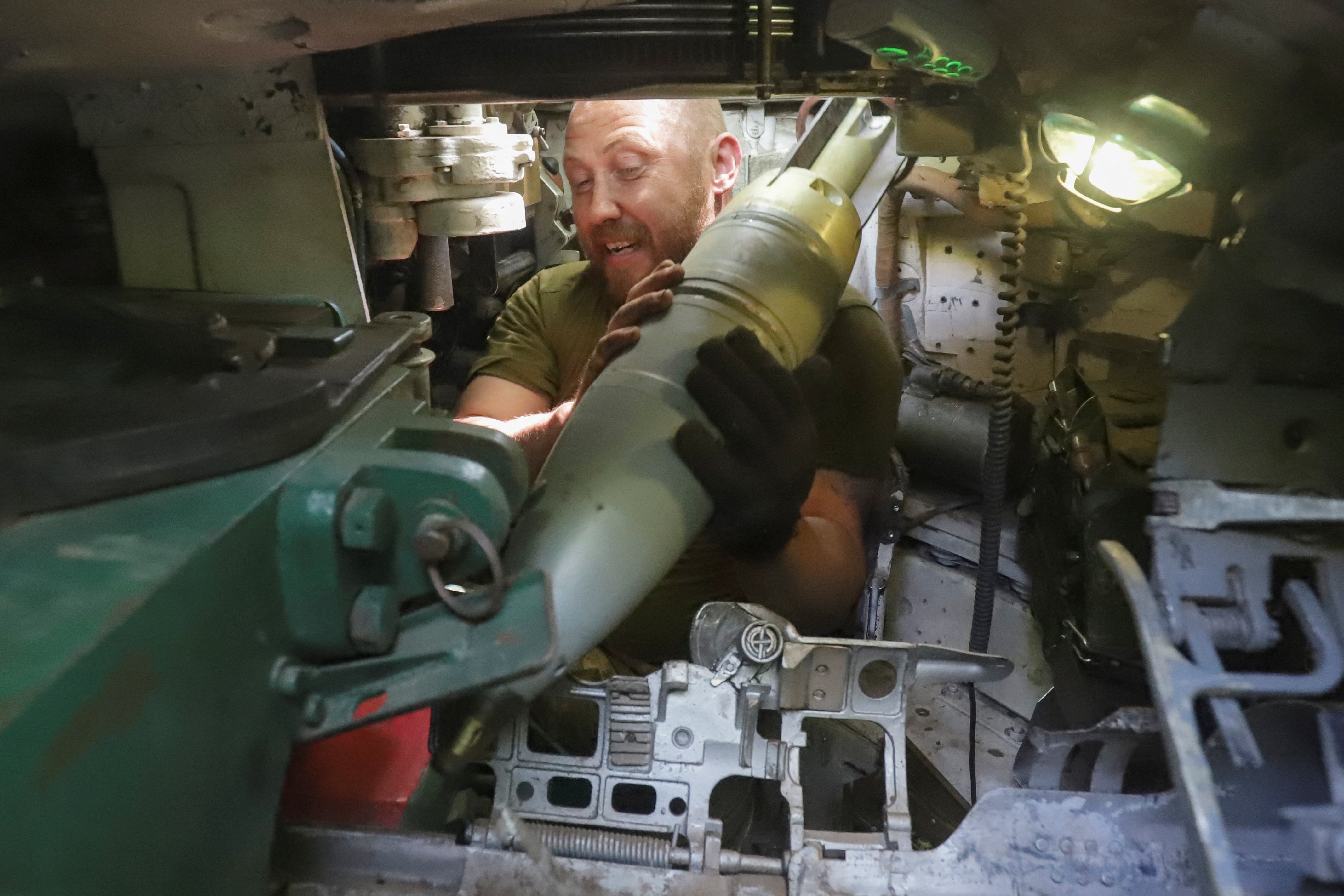Ukraine has a weapons wishlist for the West as war reaches crucial point
Officials will be going to Brussels on Wednesday with a breakdown of what is needed to counter Russian forces, writes Kim Sengupta, with Kyiv insisting that supplies can make a critical difference in the Donbas


Defence ministers from Nato and Ukraine will meet in Brussels this week to discuss weapons supplies to Kyiv, at the most critical time in the war since the earliest days of Russia’s invasion.
Vladimir Putin’s expectation of a blitzkrieg that would lead to the capture of the capital, Kyiv, and the country’s second city, Kharkiv – and allow him to impose regime change – have been thwarted. But the euphoria over Ukrainian resilience and resistance, and Russian retreat, has been replaced by deep trepidation over the unfolding course of the conflict in the Donbas.
There, Ukrainian forces have been heavily outgunned by those of the Kremlin – who can fire from a far greater range – while also running out of ammunition. The relentless salvos have claimed a lethal cost, with up to 100 soldiers being killed every day, and 300 injured.
The Russians are also taking heavy losses, but they are also making gains. Slowly, but of strategic value. In the east they have taken most of the city of Sievierodonetsk, and are continuing fierce attacks on Lysychansk. The capture of the two places would give Russian forces control of the whole of the Luhansk region, and a route into the rest of the Donbas.
Two of the three bridges to Sievierodonetsk across the Siverskyi Donets River have been destroyed. Ukrainian forces remaining there must “surrender or die” according to a demand from Eduard Basurin, a senior official of the separatist “Donetsk People’s Republic”. Basurin has also claimed, without providing evidence, that the third bridge has been blown up.
If Sievierodonetsk does get cut off and surrounded, and there is a large-scale surrender of Ukrainian troops, as happened in Mariupol, hard questions are likely to be asked. A number of senior military and political officials have been asking Volodymyr Zelensky’s government for a strategic withdrawal from Sievierodonetsk.
The Ukrainian government insists that adequate supplies of Western weapons and ammunition can lead to a reverse of its losses. Officials will be going to Brussels on Wednesday – part of the Rammstein process on supporting Kyiv – with a list of what is needed to counter Russian forces. Britain has become a key enabler in coordinating arms supplies among allies for Ukraine. The defence secretary, Ben Wallace, travelled to Kyiv at the weekend to meet President Zelensky and Ukraine’s defence minister, Oleksii Reznikov, to discuss the requirements of the country’s armed forces.
Mikhail Podolyak, an adviser to President Zelensky, said in the run-up to the meeting that Ukraine needs 1,000 155mm-calibre howitzers, 300 multiple-launch rocket systems (MLRS), 500 tanks, 2,000 armoured vehicles, and 1,000 drones.
A breakdown of the wishlist, The Independent understands, includes M270A1 (A2) M142 high-mobility rocket systems (HIMARS) – as well as M30, M31, M30A1 and M31A variants; armoured personnel carriers (APCs) and infantry fighting vehicles (IVFs) such as M1126 Stryker and Bradley M2A2/3, and around 480 M113 and M1117 Guardian armoured security vehicles (ASVs).
Ukrainian forces, officials say, have lost 700 armoured vehicles in the last three months, and replacements are urgently needed.
Artillery systems to be requested include around 200 systems of 155 mm M777A2 and 105mm M119A3 towed howitzers, and 90 M109 self-propelled howitzers, along with M1156 precision guidance kit (PGK).
Drones have played a key role for the Ukrainian forces, with the Turkish-made Bayraktar being so effective that a war anthem was composed in its honour. The Ukrainian military is now keen to acquire Western models, including the Switchblade 600, Phoenix Ghost, ScanEagle 2, RQ-21 Blackjack, MQ-1C Gray Eagle and/or MQ-9 Reaper, and the Puma LE.
Just how much Nato delivers on this remains to be seen. The advanced missile systems, HIMARS and MLRS, supplied by Western states, have been few in number, and late in the day. They have not had a significant impact on the fighting in the Donbas.
One issue of concern, say British and American military sources, is the risk of technology falling into Russian hands. The HIMARS and MLRS have ranges of up to 80km and would be fired from far enough away to make this unlikely. But photos of a British Brimstone missile, with a shorter range – which was captured intact by the Russians – appeared on social media last month.
Nevertheless, the UK government may give the go-ahead for the supply of a naval version of the Brimstone at the Brussels meeting – despite consternation at the Russian seizure. At the last session of the Rammstein process, in May, the Danish government agreed to supply American-made Harpoon anti-ship missiles, but there is an acceptance that Kyiv’s request for more naval firepower needs to be met, given the continuing Russian blockade of the southern ports.
Robert Emerson, a British security analyst, said: “Western technology falling into Russian hands is an understandable worry. But such technology does get captured in wartime. The Ukrainians have got hold of Russian kit, which has been of great interest to Nato. The fact of the matter is that the West needs to give Ukraine the arms it needs to help it defend itself against Russia, or bear the consequences.”
Andriy Zagorodnyuk, a former Ukrainian defence minister and now the chair of the Centre for Defence Strategies in Kyiv, said: “We have said from the outset that the Russians have much more weaponry than us; anyone could see that was the case. The fact that Ukraine will run out of stockpiles was also evident, and we have communicated this to our allies from the first months of the war.
“At present, we have tens of countries involved in helping Ukraine. We are grateful for this. But this help comes in single units and, as a result, we still have a severe shortage of equipment on the whole. We hope very much that we’ll get some good news on Wednesday [in Brussels], because right now it is often unclear which systems are coming, when they are coming, and the quantities involved of each type.
“On April 26, the US secretary of defence, Lloyd Austin, committed to ‘move heaven and earth’ to help Ukraine defend our country and win. We would welcome an implementation of that policy statement. As we have shown, we can fight for ourselves – what we need is help from our allies.”
Join our commenting forum
Join thought-provoking conversations, follow other Independent readers and see their replies
Comments